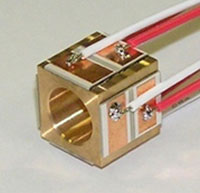Piezoelectric actuators: Why cubic?

An actual cubic actuator <br>Copyright : TUT<br><br>
Here, Tomoaki Mashimo and Shigeki Toyama analyzed the vibrational behavior of cubic stators based on an energy method, which distinguishes components of mechanical energy.
By changing the design of stators—especially the length in the direction of the through-hole axis—the researchers clarified how the vibrational modes are in accordance at one equal frequency in cubic shape.
The energy method described in this paper showed that the mechanical energy of two specific vibrational modes is in equilibrium. The shape for which the stator achieves equilibrium energy was found to be a cube.
This approach should be useful for not only studies on vibration, but also for design the stators with an easy-to-use modal analysis method.
Reference:
Tomoaki Mashimo and Shigeki Toyama.
Vibration Analysis of Cubic Rotary-Linear Piezoelectric Actuator.
IEEE Transactions on Ultrasonics, Ferroelectrics, and Frequency Control 58, 844–848, (2011).
Digital Object Identifier (DOI): 10.1109/TUFFC.2011.1877
Tomoaki Mashimo is now at the Electronics-Inspired Interdisciplinary Research Institute, Toyohashi University of Technology.
Department website: Electronics-Inspired Interdisciplinary Research Institute (EIIRIS) http://www.eiiris.tut.ac.jp/
Media Contact
All latest news from the category: Power and Electrical Engineering
This topic covers issues related to energy generation, conversion, transportation and consumption and how the industry is addressing the challenge of energy efficiency in general.
innovations-report provides in-depth and informative reports and articles on subjects ranging from wind energy, fuel cell technology, solar energy, geothermal energy, petroleum, gas, nuclear engineering, alternative energy and energy efficiency to fusion, hydrogen and superconductor technologies.
Newest articles

Sea slugs inspire highly stretchable biomedical sensor
USC Viterbi School of Engineering researcher Hangbo Zhao presents findings on highly stretchable and customizable microneedles for application in fields including neuroscience, tissue engineering, and wearable bioelectronics. The revolution in…

Twisting and binding matter waves with photons in a cavity
Precisely measuring the energy states of individual atoms has been a historical challenge for physicists due to atomic recoil. When an atom interacts with a photon, the atom “recoils” in…

Nanotubes, nanoparticles, and antibodies detect tiny amounts of fentanyl
New sensor is six orders of magnitude more sensitive than the next best thing. A research team at Pitt led by Alexander Star, a chemistry professor in the Kenneth P. Dietrich…





















